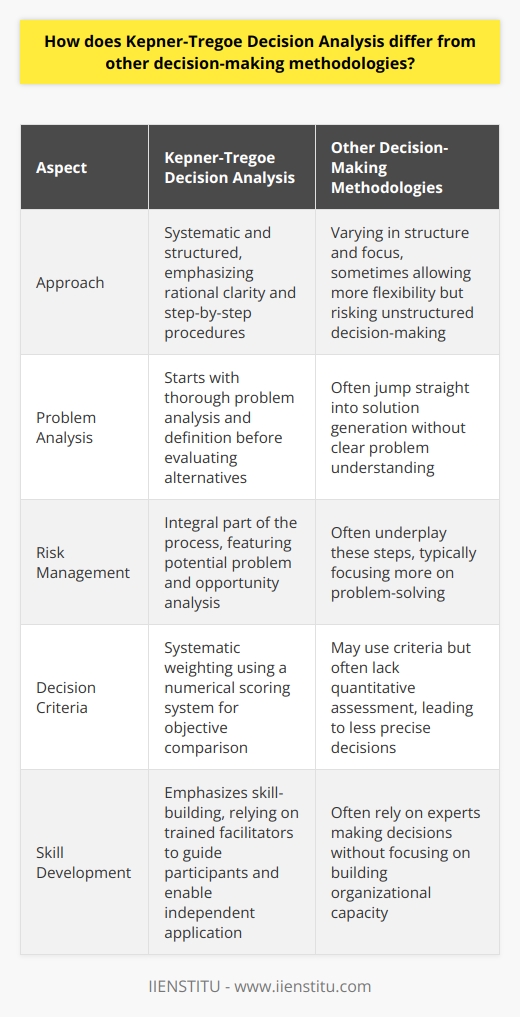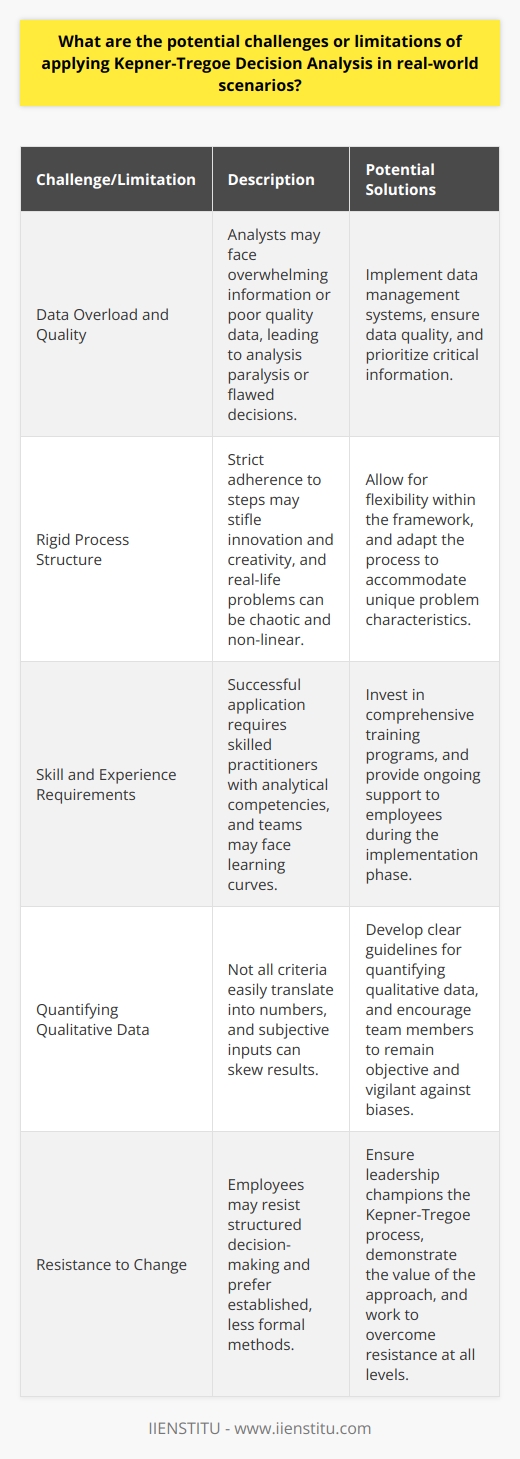
Decision-making plays a critical role in the success of any business, necessitating methodologies that can streamline and enhance the process. The Kepner-Tregoe Decision Analysis stands out as a time-tested and systematic technique designed to tackle complex business problems effectively. This article examines the intricate details, steps, and nuances of the Kepner-Tregoe method, assessing its advantages and possible limitations. With the dual aims of providing a comprehensive overview and practical guidance, this post will serve as an essential resource for professionals seeking to enhance their decision-making skills through problem solving training courses or an online certificate course.
🔊 Ready for an auditory reading experience? Just click the 'Play' button right below this text and immerse yourself in our captivating audio version. Ideal for those who prefer listening to stories, or for times when you're multitasking. Engage with our content effortlessly - one simple click is all it takes to transform your reading into listening!
What is Kepner-Tregoe Decision Analysis?
The Kepner-Tregoe Decision Analysis is a structured methodology facilitating a careful, step-by-step approach to decision-making. Created by Charles Kepner and Benjamin Tregoe in the 1960s, the method provides a framework for identifying, analyzing, and resolving problems. Its principles are deeply rooted in rationality and a systematic approach, guiding users to cut through complexity by focusing on logical analysis and factual data.
The logical sequence of the decision-making process is what sets the Kepner-Tregoe method apart from less structured approaches. It compels users to look beyond the symptoms of a problem and concentrate on distinguishing causes from effects. This segmentation helps in clarifying issues, setting priorities, and making more informed choices.
An illustrative example of Kepner-Tregoe Decision Analysis in real-world situations could involve a manufacturing company facing a decline in product quality. By employing this method, the company can systematically dissect the issue, analyze potential causes, and decide on the most effective course of action to maintain quality standards while minimizing disruptions to production.
Steps involved in the Kepner-Tregoe Decision Analysis
Stage One: Situation Analysis
Definition and understanding the problem
At this initial stage, decision makers must clearly define the problem at hand. This means distinguishing between actual problems and perceived problems—focusing on concrete issues rather than symptoms. The Kepner-Tregoe methodology emphasizes the importance of factual information in defining problems, thereby establishing a clear objective for the resolution process.
Prioritizing problems
Not every problem demands immediate attention, and the Kepner-Tregoe Decision Analysis acknowledges this by incorporating a prioritization framework. Decision makers are encouraged to rank problems based on the urgency and impact on the business, setting the stage for an efficient allocation of resources to areas where they are most needed.
Stage Two: Problem Analysis
Identifying root causes
With the problems defined and prioritized, the next step is to drill down into the root causes. This in-depth analysis requires questioning and exploring all possible sources of the problem, often employing tools such as the 'five whys' technique to peel back layers and reveal underpinning issues.
Verifying root cause
Once potential causes are identified, they must be systematically verified against the evidence. It is crucial in the Kepner-Tregoe process to investigate each hypothesized cause and test it against existing data, reducing the risk of misdiagnosis and ensuring that the subsequent steps in the decision-making process are founded on an accurate understanding of the problem.
Stage Three: Decision Analysis
Evaluating alternatives
Decision-makers analyze different courses of action by listing out needful objectives and comparing potential solutions accordingly. Kepner-Tregoe encourages a comprehensive evaluation where alternatives are weighted against the objectives, with the aim of pinpointing the most beneficial outcome.
Risks associated with each alternative
In the evaluation stage, risks are a key consideration in the Kepner-Tregoe methodology. Each potential solution comes with its set of risks, and it is crucial to understand and manage these risks before any decision is finalized.
Stage Four: Potential Problem Analysis
Implementing the decision
Implementation involves not just enacting the chosen solution but also preparing for potential fallouts and monitoring the results. The Kepner-Tregoe Decision Analysis suggests having contingency plans in place which can be executed if things don't go as expected.
Reviewing and learning
Post-implementation review is an integral part of the decision-making cycle. This stage includes assessing the outcome against the objectives and learning from both successes and setbacks to improve future decision-making processes.
Example case elaborating on each stage
To further cement understanding, we might consider a technology company that has decided to integrate a new software system. Following the Kepner-Tregoe process, it would start by clearly defining the objectives of the integration, proceed to identify and solve potential issues that could arise, thoroughly evaluate all possible software systems and vendors, take into account risks and prepare mitigation strategies, and conclude with the implementation, monitoring, and review of the chosen solution.
Advantages and Limitations of Kepner-Tregoe Method
Discussion on the positives of this analytical approach
The Kepner-Tregoe Decision Analysis shines with its disciplined, step-by-step approach that can reduce the subjectivity and bias often present in decision-making processes. It is lauded for fostering clarity, improving communication among stakeholders, and leading to more robust and defendable decisions.
Limitations and potential setbacks of Kepner-Tregoe Decision Analysis
However, this methodology is not without its drawbacks. The very rigor that defines the Kepner-Tregoe process can also render it somewhat inflexible. In situations where quick decisions are necessary, the method's structured nature might be seen as a hindrance. Additionally, it relies heavily on the accurate and comprehensive gathering of data, which in some scenarios may not be possible or practical.
Comparing the Kepner-Tregoe method with other decision-making tools
In comparison with other decision-making tools, such as SWOT analysis or the Delphi Technique, Kepner-Tregoe offers a more comprehensive framework that encompasses the entire decision-making cycle from problem identification to post-implementation review. It can be preferable in situations where the depth of analysis is crucial, though it might be considered too cumbersome for more straightforward decision scenarios.
Real-life examples demonstrating advantages and limitations
Real-life applications, like a healthcare provider balancing cost-efficiency with patient care or a financial institution evaluating investment opportunities, demonstrate the method’s utility in complex and data-rich environments, highlighting both its effectiveness in thorough decision-making and its potential limitations when time is of the essence.
Practical Tips for Implementing Kepner-Tregoe Decision Analysis
Best practices when utilizing Kepner-Tregoe Decision Analysis
To effectively implement the Kepner-Tregoe Decision Analysis, organizations should invest in training staff to understand and apply the methodology correctly. Encouraging a culture of questioning and objective analysis can also aid in seamless integration of the process into business operations.
Misconceptions and common mistakes to avoid
It is essential to avoid common pitfalls such as rushing through stages, neglecting comprehensive data collection, or failing to involve key stakeholders. Each step in the Kepner-Tregoe process should be given due time and consideration to ensure that the underlying principles of systematic analysis are upheld.
Additional resources for mastering the process
To gain in-depth expertise, individuals may participate in problem solving training courses or pursue an online certificate course in Kepner-Tregoe Decision Analysis. Such resources can provide interactive learning experiences and case studies to solidify one's grasp of the method.
Conclusion: The Impact of sound Decision Analysis on Business Success
Summarization of key points covered
This article has traversed the various aspects of Kepner-Tregoe Decision Analysis, elucidating its structured approach on how organizations can tackle complex problems and make sound decisions. We have delved into its systematic processes, revealed its benefits, and discussed its limitations.
The strategic influence of Kepner-Tregoe Decision Analysis on business growth and success
The strategic application of the Kepner-Tregoe method can significantly influence business growth and success. By facilitating better decision-making, it can lead to higher-quality outcomes, improved efficiency, and stronger competitive positioning.
Encouragement to adopt systematic decision-making processes in business for overall success
Businesses are encouraged to adopt systematic decision-making processes like Kepner-Tregoe to navigate the complex landscape of modern business challenges. Embracing such frameworks not only enhances the quality of decisions but also reinforces organizational learning and resilience.
Frequently Asked Questions
What are the key steps involved in Kepner-Tregoe Decision Analysis and how do they contribute to effective problem-solving?
Understanding Kepner-Tregoe Decision Analysis
Kepner-Tregoe Decision Analysis stands as a structured methodology. It helps individuals and organizations solve problems effectively. This methodology bases itself on a rational framework. It promotes thorough analysis and clear decision-making.
Key Steps in the Kepner-Tregoe Decision Analysis
The Kepner-Tregoe process breaks down into four critical steps. These contribute to an analytical approach to problem-solving.
Situation Appraisal
Identify concerns and outline priorities. Start with listing all the issues. Distinguish concerns from actual problems. Questions start the process. They focus on "what", "why", and "how" regarding the issues at hand. This step ensures a structured understanding of the situation.
Problem Analysis
Clarify the problem. Here, you examine the issue in depth. Start with identifying the problem's core. Next, describe the problem explicitly. Consider what the problem is and isn't. Observe when and where it occurs. Find out why the issue matters. This step seeks to limit the problem's scope.
Decision Analysis
Explore options and make decisions. Begin by delineating your objectives. Prioritize these objectives. Develop alternatives based on these priorities. Evaluate these by comparing them to your criteria. Make the decision with the best alignment to your goals. Here, you ensure selections are systematic and justifiable.
Potential Problem Analysis
Anticipate future issues and plan. Consider what could go wrong. Predict potential problems and prepare for them. Plan preventative actions. Establish contingency plans. This step aims to minimize future risks.
Each Step's Contribution to Problem-Solving
Kepner-Tregoe Decision Analysis contributes to effective problem solving in several ways:
- Clarifies complexity: By breaking down problems, it makes the complex manageable.
- Promotes data-driven decisions: The focus on evidence and criteria facilitates objective choices.
- Improves communication: Clear frameworks aid in articulating problems and solutions.
- Increases efficiency: Structured approaches save time and reduce uncertainty.
- Enhances risk management: Anticipating challenges enables proactive measures.
Conclusion
Kepner-Tregoe Decision Analysis stands as a powerful tool. It guides teams through the problem-solving maze. Its structured, step-wise approach fosters clarity, decision-making, and risk planning. Ultimately, it can drive effective solutions to complex business challenges.

How does Kepner-Tregoe Decision Analysis differ from other decision-making methodologies?
Kepner-Tregoe Decision Analysis Fundamentals
Kepner-Tregoe Decision Analysis stands unique. It offers a systematic approach. Other methodologies vary in structure. They also differ in focus. Kepner-Tregoe emphasizes rational clarity. It prioritizes a step-by-step procedure. This process ensures thoroughness. Each step builds on the previous one. This yields comprehensive decision-making.
Emphasis on Problem Analysis and Evaluation
Kepner-Tregoe starts with problem analysis. It distinguishes itself with a particular focus. The focus lies on problem understanding. Clarity and definition matter here. These elements precede alternative evaluation. This contrasts with other methods. Many alternate techniques jump straight into solution generation. In Kepner-Tregoe, one cannot proceed without clear problem understanding.
Potential Problem and Opportunity Analysis
Risk management is integral to Kepner-Tregoe. It features potential problem analysis. This analysis identifies what could go wrong. It also includes potential opportunity analysis. This targets what could go right. Other methods often underplay these steps. They typically focus on problem-solving. Kepner-Tregoe balances problem-solving with preemptive assessment.
Structured Decision-Making Process
Kepner-Tregoe promotes a structured approach. It delineates explicit steps. Each step has defined objectives. The structure promotes disciplined thinking. It discourages cognitive biases. This is different from less structured methodologies. Many such methods allow more flexibility. But they risk unstructured decision-making.
Criteria Weighting and Decision Analysis
Decision criteria receive systematic weighting in Kepner-Tregoe. It uses a numerical scoring system. This compares options objectively. Other methods might use criteria. Yet, they often lack quantitative assessment. Kepner-Tregoe's use of weights adds precision. This enables clear, defensible choices.
Focus on Skill Development
Kepner-Tregoe emphasizes skill-building. It relies on trained facilitators. Facilitators guide participants through the process. This aims at skill transfer. Participants learn to apply the method independently. Other methodologies do not focus as much on skill development. They often rely on experts. These experts make the decisions without building organizational capacity.
Broad Application Spectrum
The versatility of Kepner-Tregoe stands out. It suits diverse problems. These can be technical or managerial. It supports individual or group decisions. Other methods might specialize. They could target specific domains or problem types. Kepner-Tregoe offers a comprehensive toolkit. This toolkit can adapt to a multitude of scenarios.
In summary, Kepner-Tregoe Decision Analysis provides a detailed, methodical approach. It enforces disciplined problem analysis. It anticipates risks and opportunities. The process is highly structured with quantitative criteria evaluation. It simultaneously fosters individual and organizational capability. These qualities distinguish Kepner-Tregoe from other decision-making methodologies. It excels in promoting clear, rational, and well-supported decisions.

What are the potential challenges or limitations of applying Kepner-Tregoe Decision Analysis in real-world scenarios?
Understanding Kepner-Tregoe Decision Analysis
Kepner-Tregoe Decision Analysis stands as a structured methodology. It aids in problem-solving and decision-making. Developed by Charles Kepner and Benjamin Tregoe, the method is systematic. It requires analysts to evaluate problems based on available data.
This process focuses on critical thinking. Analysts must address potential biases. They aim for rational decision-making. While this approach has merits, real-world application presents challenges.
Issues with Complex Data Interpretation
Data overload poses a significant problem. Analysts may face overwhelming information. This can lead to analysis paralysis. Critical decisions require timely analysis. Delayed conclusions can disrupt business operations.
Quality of data also impacts analysis. Poor data may lead to flawed decisions. Decisions rely on the strength of available information. Analysts must often make decisions with incomplete data sets.
Adhering to a Structured Process
The method demands strict adherence to steps. Teams may find this rigid. Innovation thrives in more flexible environments. Creativity can suffer under rigid frameworks. The process also assumes logical progression. Real-life problems can be chaotic and non-linear.
Skill and Experience Requirements
Successful application needs skilled practitioners. These individuals must have analytical competencies. They must understand complex decision-making frameworks. Training is essential for teams. Without training, employees may struggle.
Teams unfamiliar with the Kepner-Tregoe approach often face learning curves. Implementation becomes time-consuming. Adjustment periods can slow down processes initially.
Difficulty in Quantifying Qualitative Data
The method often quantifies factors for analysis. Not all criteria easily translate into numbers. Qualitative data quantification presents its challenges. Subjective inputs can skew results.
Objectivity is vital. Yet personal biases can influence decisions. Teams must remain vigilant against such challenges.
Resistance to Change
Change meets resistance in most organizations. Introducing new methodologies is no different. Employees may resist structured decision-making. They might prefer established, less formal methods. Buy-in is crucial from all levels.
Leaders must champion the Kepner-Tregoe process. They should work to overcome resistance. Employees need to see the value of this approach.
Cost and Resource Allocation
Implementing this methodology requires investment. Resources must be allocated for training. This includes both time and money. Small organizations may find this prohibitive. ROI calculations can deter adoption.
Limited Application in Certain Scenarios
Certain scenarios may not lend themselves to this method. Crisis situations require rapid responses. The structured approach suits less urgent problems better. Situations needing emotional intelligence can also pose problems.
Rigid analysis frameworks might not fit well. Human elements can be unpredictable. Kepner-Tregoe may not capture all nuances.
Conclusion
Kepner-Tregoe Decision Analysis is a robust tool. Yet, like any framework, it has limitations. Real-world scenarios bring complex challenges. Analysts must navigate these carefully. Tailoring the approach to fit specific needs often works best.
Understanding constraints allows for better preparation. Teams can address these limitations head-on. This preparation promotes a more successful application of Kepner-Tregoe.


